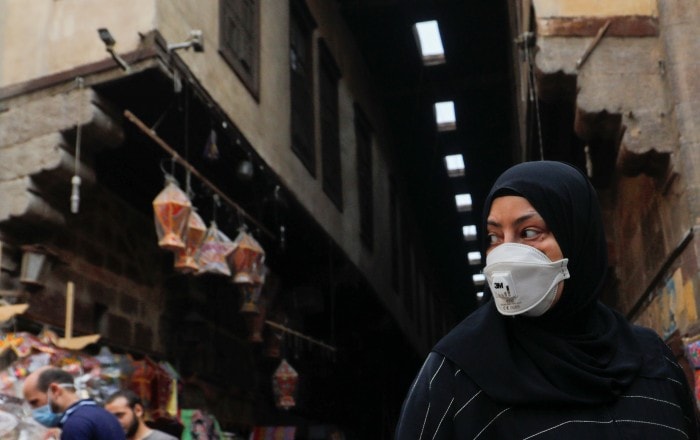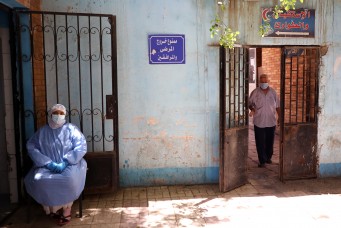Long-term Implications of COVID-19
Most policy-makers are taking on COVID-19 as a one-time challenge, but a multi-round scenario could have disastrous implications for the global economy.

A woman wearing a protective face mask, amid concerns over the coronavirus disease (COVID-19) at Al Khayamia street market in old Cairo, Egypt April 16, 2020. Amr Abdallah Dalsh/Reuters
The COVID-19 pandemic is expected to propel the world into the worst economic downturn since the Great Depression but analysts say the scale and intensity of this recession may vary significantly across countries. While the International Monetary Fund (IMF) projects severe economic contraction among advanced economies and the oil-exporting MENA states, many emerging markets are still expected to achieve positive growth – among them is Egypt.
In a webinar titled “Economic Implications of COVID-19: A Global and National View” hosted by the American University in Cairo (AUC)’s School of Business, associate professor Ahmed El Safty suggested the most likely scenarios for recovery, as well as the potential risks that policy-makers must account for.
El Safty began by retracing the roots of the global economy’s current predicament to two separate crises. The first is the pandemic itself and the ensuing containment measures. The second is the oil price war set off by the collapse of an alliance between Russia and the OPEC cartel, which further exacerbated the impacts of economic lockdown.
As of now, on the global scale, the outlook is grim. El Safty relayed IMF projections the world economy is expected to contract by 3 percent in 2020, and relief measures undertaken by governments will result in massive public debt accumulation. The rich world will recover with difficulty, while many emerging economies will require assistance from their advanced counterparts and from international institutions. “This, however, is only the baseline scenario,” he warned; noting that those estimates are built on the assumption that the economy will begin to recover by mid-2020.
In recent weeks, world governments have implemented expansive stimulus packages to cushion the economic impacts of the crisis, including tax relief, increased social spending, and spending on healthcare infrastructure. Central banks have dramatically cut down interest rates and launched asset purchase programs of public and private sector securities. Those measures, nonetheless, can only do so much to counter the many obstacles ahead.
As businesses’ capacities for adaptability are put to the challenge, not all will be able to smoothly transition to working from home (WFH). Despite government efforts to support small and medium enterprises, we will likely witness a sharp increase in the number of bankruptcies. El Safty further noted that strong government interference in the private sector may become an issue: in an attempt to keep stock markets afloat, central banks are dramatically expanding their balance sheets and potentially acquiring toxic assets. “Once the crisis is averted, the line between private and public sector activity will have to be redrawn,” he cautioned.
On the regional scale, the outlook is most concerning for the oil-exporting economies of the Arab world. The UN Economic and Social Commission for West Asia (ESCWA) has forecast the loss of $42 billion in net oil revenues by the end of this year, and a 1.2 percent increase in regional unemployment. According to IMF projections, GCC countries will record overall negative growth in 2020 and, El Safty added, some could take up to 2022 to recover from the present shock.
On a national level, the outlook is more mitigated. The Egyptian economy seems to be faring better than its less diversified oil-exporting counterparts. Despite significant losses in many of its primary sources of income, the country is still expected to record a positive growth rate of 2 percent in 2020. The budget deficit is projected to rise from 7.3 to 7.7 percent, before dropping to 6.6 percent in 2021; while the current account deficit will see a moderate increase from 3.6 to 4.3 percent, according to IMF projections. El Safty largely attributes the country’s relative resilience to the IMF reform program implemented in 2016.
Policy-makers must still, however, account for several important setbacks. Most notable among them is the shock that the pandemic has dealt to the country’s foreign reserves, which have already fallen from $45.4 billion in early 2020 to $40.1 billion by the end of March.
Egypt’s primary foreign exchange resources are remittances of Egyptians working abroad, tourism, and Suez Canal revenues. Put together, those account for around 14 percent of Egypt’s GDP. Concurrently, all three count among the country’s most drastically impacted income sources. Using the Social Accounting Matrix (SAM) multiplier model for Egypt, researchers at the International Food Policy Institute (IFPRI) have suggested that if the crisis persists for three to six months, the cumulative loss from these external shocks could amount to between 2.1 and 4.8 percent of GDP.
Workers’ remittances have been Egypt’s most stable and resilient source of foreign exchange, and were key in helping the country stay afloat through economic instability in 2011. According to World Bank projections however, global remittances are expected to decline by 19.7 percent in 2020. Prolonged economic recession in the GCC countries will be of particular detriment to Egyptian workers’ remittances.
In FY 2018-19, the tourism sector recorded its highest revenues since 2011. In the advent of the pandemic however, “tourism was the first hit sector, and it will most likely be the last to recover, as there is no telling when international travel will resume at pre-COVID levels” El Safty explained.
Meanwhile, as a result of the oil price crash, the Suez Canal faces fierce competition from other maritime trade routes. Reductions in the volume of loaded cargo have resulted in higher cost per unit, significantly altering the cost structures for shipping companies: for many, it is now more cost-efficient to go around the Cape of Good Hope route than to cross through the Egyptian canal.
On the capital and financial front, El Safty turned to Egypt’s heavy reliance on portfolio investment since 2016. In times of economic prosperity, he explained, this can serve as a reliable source of foreign exchange. In times of economic recession, however, portfolio investment outflow becomes a major source of drainage on foreign exchange, as evidenced by the aftermath of the 2011 uprising. This is all the more concerning given that Foreign Direct Investment (FDI) has not picked up in the years since the implementation of the IMF reforms, and is highly unlikely to see much improvement in the wake of the pandemic.
The Egyptian government has taken drastic measures to deal with the economic impact of the outbreak. Following an emergency meeting on March 16, the Central Bank of Egypt (CBE) slashed interest rates by 300 basis points and has since launched an EGP 20 billion stock purchase program to help keep the market afloat. In late March, a 75 percent increase was made to the monthly allowances of medical professionals. In early April, President Abdel-Fattah El Sisi announced an EGP 100 billion stimulus package, including an EGP 500 stipend for each of the country’s informal workers. Tax reliefs were provided to businesses across various sectors, and energy costs lowered to support the industry sector.
Egypt has also requested assistance from the IMF under the Fund’s Rapid Financing Instrument (RFI), which is available to all member countries facing urgent balance of payment needs. The government has also issued a request for a Stand-By Arrangement (SBA), an instrument tailored primarily to middle-income countries, which provides them with short-term financing in times of economic crisis. It remains to be seen how swiftly domestic measures and international aid can restore Egypt’s economic growth to pre-COVID levels.
In outlining the most likely pathways toward global economic recovery, El Safty pointed to three scenarios which could escalate the present crisis. First, containment measures could take longer than predicted to curb the outbreak, which would mean a longer period of economic stagnation in 2020. Second, countries could successfully manage to curb the outbreak in 2020, only to be struck with a second wave of the pandemic in 2021. Third, we could end up dealing with both a longer outbreak this year and a second wave in 2021.
Depending on which (if any) of the above scenarios unfold, the present recession and subsequent recovery could be L-shaped, V-shaped, U-shaped, or W-shaped. An L-shaped recession, where growth experiences a sharp decline and fails to return to pre-recession levels of output for years, is unlikely, said El Safty.
The best-case scenario is a V-shaped recession, where a sharp and fast economic downturn is followed by an equally swift recovery. Some experts are maintaining hope for a V-shaped recovery, and many have cited the Chinese economy’s seemingly swift rebound in the weeks since lockdown measures were lifted in the country. This outcome would require continuous mass testing to allow for a safe reopening, coupled with expansive government stimulus to keep businesses and consumers afloat. Such resources, however, are not available to all governments.
The most likely outcome, in El Safty’s view, is a U-shaped recession. In this type, a long period of decline is followed by a long period of recovery: a more drawn-out process than the V-shaped alternative. A U-shaped recession is most probable given that a safe and sustainable economic reopening will have to be undertaken gradually, in order to avoid what El Safty described as the worst case scenario: a W-shaped recession.
In a W-shaped recession, the economy experiences an initial decline followed by a brief period of swift recovery, before rapidly falling into a second period of decline. Drawing on Allianz chief economic adviser Mohamed El-Erian’s comments, El Safty explained that most policy-makers are taking on COVID-19 as a one-round challenge. If economic activity resumes at pre-COVID levels too quickly, however, we risk embarking on a second wave of the pandemic, by which point governments of the world will have exhausted their resources in trying to curb the first wave. A multi-round scenario could thus have disastrous impacts on the global economy.
Amina Abdel-Halim is associate editor at the Cairo Review of Global Affairs. Her work has appeared in Ahram Online, Al Ahram Weekly, the Cairo Review of Global Affairs, and the Cairo International Film Festival’s Daily Bulletin.
Read More



